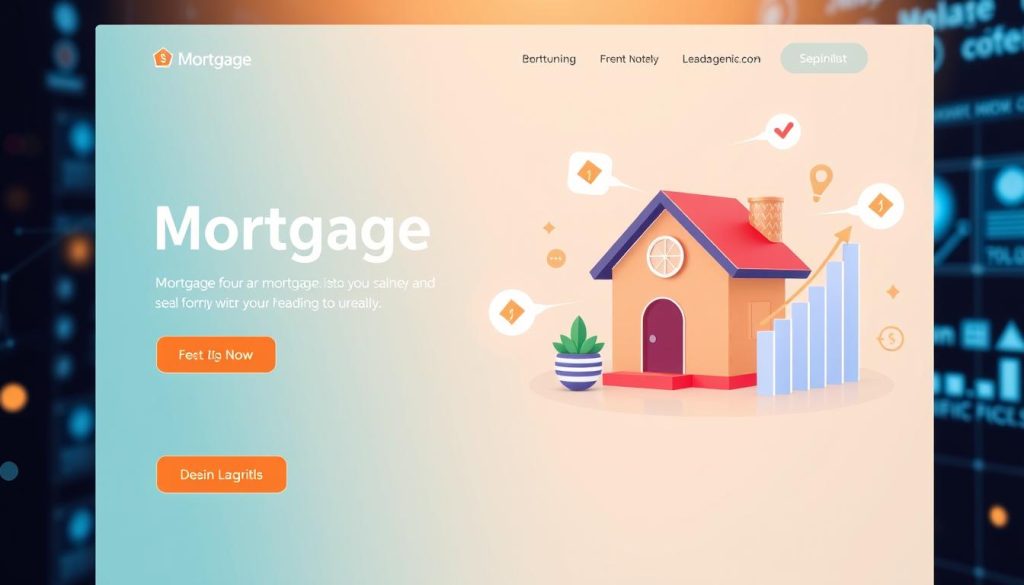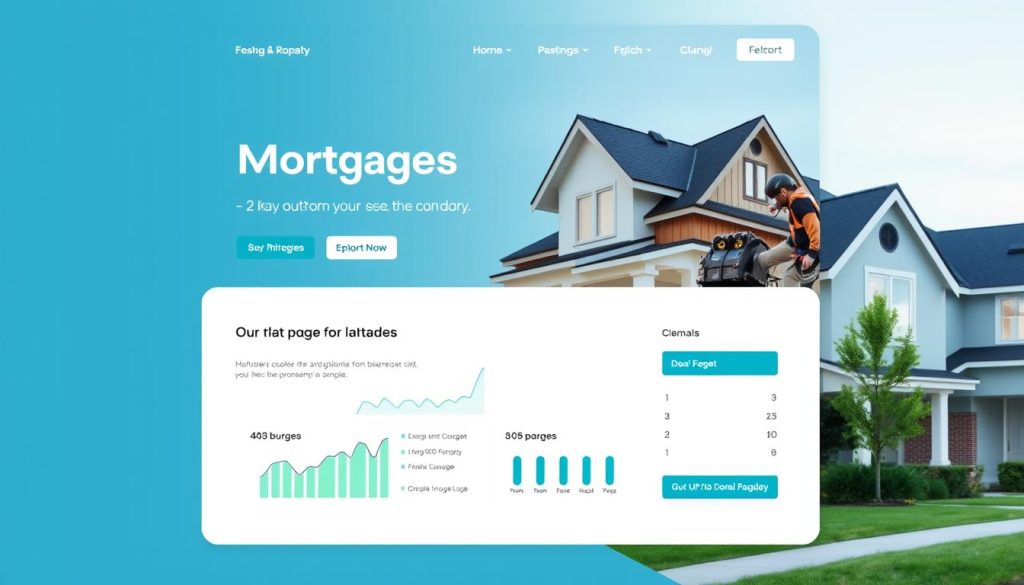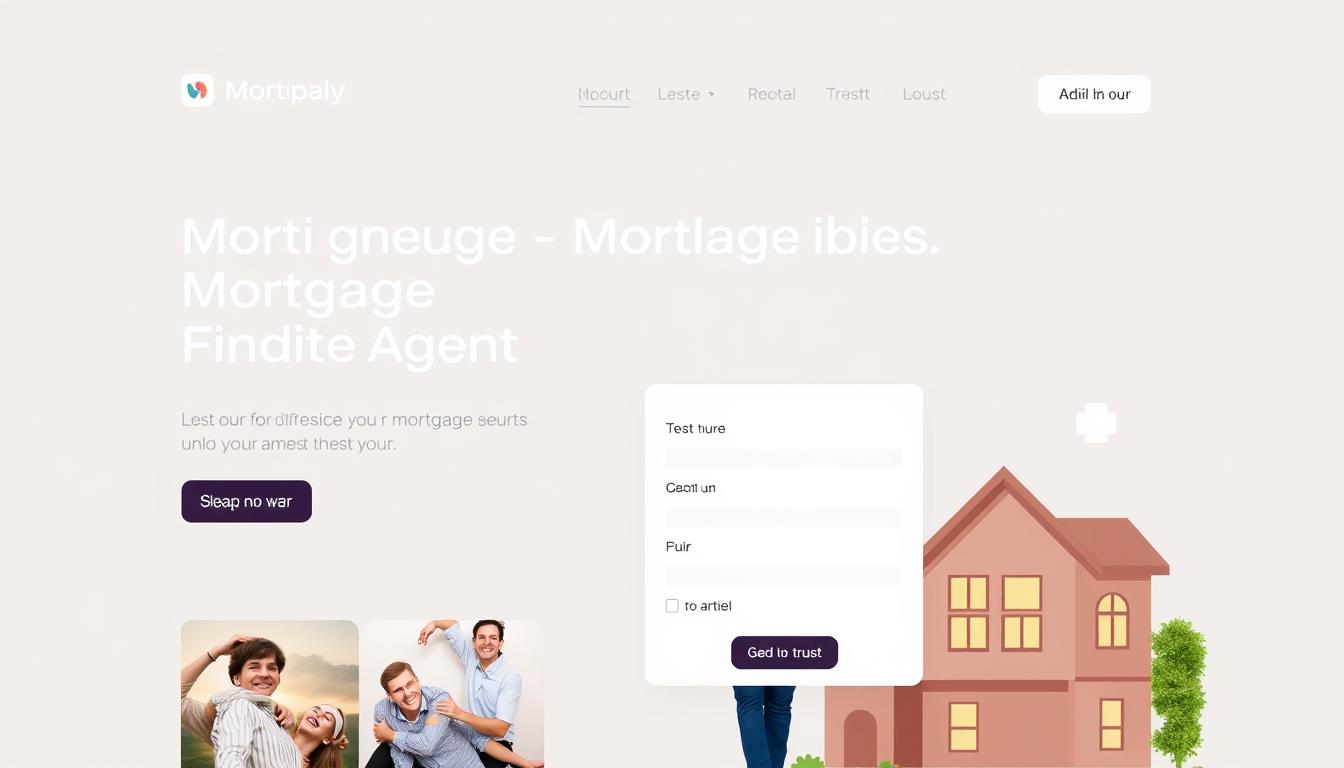Creating a strong mortgage lead funnel is key for any mortgage agent or broker’s success. At the core, effective landing pages act as the first step in turning website visitors into leads. This guide will show you how top mortgage pros make their landing pages work better and increase conversions.
We’ll cover the mortgage customer journey and how to write persuasive copy. This article gives you the insights and steps to improve your mortgage lead funnel. It’s useful for both experienced mortgage brokers and newcomers. You’ll learn how to make landing pages that draw in, engage, and convert your audience.
Key Takeaways
- Understand the importance of landing pages in the mortgage industry and their role in the customer journey
- Discover the key elements of effective mortgage landing pages, including compelling offers and persuasive copywriting
- Learn effective mortgage marketing strategies to drive traffic to your landing pages, including SEO and paid advertising
- Explore conversion optimization techniques to turn website visitors into qualified leads
- Gain insights into the best practices for mortgage broker landing pages and what makes them successful
- Discover the importance of user experience (UX) and data-driven design for mortgage landing pages
- Streamline the online mortgage application process to enhance the customer experience
By the end of this guide, you’ll know how to make a mortgage lead funnel that stands out. It will help you reach your business goals. So, let’s get started and learn the secrets of great mortgage landing pages and lead generation.
Learn more about craftinga conversion-driven sales funnel for mortgage
Importance of Landing Pages in the Mortgage Industry
The mortgage industry is very competitive. Mortgage brokers need to stand out. That’s where landing pages help. Landing pages are key for a strong mortgage marketing plan. They connect online ads with turning visitors into leads.
Converting Mortgage Leads: Why Landing Pages Matter
Getting leads is key in the mortgage industry. Landing pages are vital for this. They grab potential customers’ attention, offer the right info, and guide them through the process. By making landing pages better at converting visitors, brokers can grow their business.
Understanding the Mortgage Customer Journey
The mortgage customer journey is complex. Landing pages are crucial in this journey. They help customers from the start to the end of the process. By meeting customers’ needs at each step, landing pages make the journey smoother and more engaging, leading to more conversions.
| Stage of Mortgage Customer Journey | Importance of Landing Pages |
|---|---|
| Awareness | Capture attention and provide valuable information |
| Consideration | Educate and guide customers through the process |
| Decision | Facilitate the loan application and conversion process |
“Landing pages are the key to unlocking the full potential of your mortgage marketing efforts. By aligning them with the customer journey, you can drive higher lead conversion rates and ultimately grow your business.”
Key Elements of Effective Mortgage Landing Pages
Creating a top-notch mortgage landing page is key to grabbing and turning leads into customers. Mortgage brokers need to focus on several important parts. These include clear calls-to-action, persuasive writing, good design, and a smooth user experience.
A clear and strong call-to-action (CTA) is vital for a good mortgage landing page. This could be a button or form that gets visitors to take the next step. This could be asking for a quote, setting up a consultation, or applying for a loan. The CTA should be easy to see and stand out on the page.
Persuasive writing is also key to turning visitors into leads. The content should be engaging, informative, and match the needs of the target audience. Mortgage brokers should use simple, clear language. They should also point out the benefits of their services to build trust and encourage action.
Good design matters a lot for a mortgage landing page. The page should look good, with high-quality images, a clean layout, and easy navigation. This makes the user experience better and helps build trust and professionalism.
The overall user experience (UX) of the landing page is also crucial. Visitors should be able to easily find what they need, move around the page, and do what they want, like apply for a loan or ask for a consultation. A smooth UX can greatly improve conversion rates and lead generation.
By focusing on these key elements, mortgage brokers can make landing pages that draw in and convert more leads. This can help drive business growth. For more tips on [mortgage website design best practices], check out Omni Online Strategies.
“Crafting an effective mortgage landing page is not just about aesthetics, but about creating a seamless user experience that guides visitors towards the desired action.”
Mortgage Marketing: Driving Traffic to Your Landing Pages
Getting qualified leads is key for a successful mortgage business. To boost your lead funnel, focus on bringing targeted traffic to your mortgage landing pages with smart mortgage marketing strategies. We’ll look at two strong methods: search engine optimization (SEO) for your landing pages and paid advertising techniques.
Search Engine Optimization (SEO) for Mortgage Landing Pages
Optimizing your mortgage landing pages for search engines helps draw in potential borrowers naturally. By using SEO best practices, your pages will show up higher in search results. This makes it easier for homebuyers to find your mortgage options. A detailed SEO strategy includes keyword research, creating engaging content, and optimizing technical aspects. This approach can bring a steady stream of qualified traffic to your pages.
Paid Advertising Strategies for Mortgage Leads
Paid advertising can give you a quick boost of mortgage leads, alongside SEO. Use platforms like Google Ads, Facebook Ads, and LinkedIn Ads for targeted campaigns. Make sure your ads and landing pages are compelling. Keep testing and refining your strategies to turn website visitors into valuable mortgage leads.
By using these mortgage marketing strategies, you can keep a steady flow of qualified traffic to your pages. This fills your lead funnel and sets your mortgage business up for success.
Conversion Optimization: Turning Visitors into Leads
In the competitive mortgage world, making the most of your website is key. Use persuasive copywriting techniques on your mortgage landing pages. This can make your audience want to take action.
Crafting Compelling Headlines
Start by making headlines that catch your visitors’ eyes. Add power words, emotional touches, and clear benefits to draw them in. This sets the stage for your content.
Engaging Copy that Resonates
Your landing page should inform and engage. Use persuasive copywriting to tackle common issues, show unique perks, and create a sense of urgency. This guides visitors towards making a choice.
Irresistible Calls-to-Action
A strong call-to-action (CTA) is crucial. Make CTAs clear, appealing, and fit your mortgage audience. They should encourage visitors to move forward in their journey.
Mastering persuasive copywriting and strategic tactics can unlock your mortgage landing pages’ full potential. This turns more visitors into valuable leads.

“The most important element of a landing page is the copy. Crafting persuasive, benefit-driven content is crucial for driving conversions in the mortgage industry.”
Landing Pages for Mortgage Brokers: What Works and Why
In the mortgage industry, a well-designed landing page can change the game in converting leads and closing deals. Let’s look at some real-world examples of successful mortgage broker landing pages. We’ll see what makes them stand out.
The landing page from [https://www.omnionlinestrategies.com/the-ultimate-guide-to-generate-sba-loan-leads-and-close-more-deals/] is a great example. It has a clean design that grabs the visitor’s attention right away. The message is clear, showing what makes the broker’s services special. The call-to-action is strong, pushing visitors to move forward in the mortgage process.
- Attention-grabbing Headline: The headline clearly communicates the primary benefit or solution the mortgage broker offers, drawing in the target audience.
- Personalized Testimonials: Authentic testimonials from satisfied clients help build trust and credibility, reassuring visitors that the broker can deliver on their promises.
- Conversion-oriented Forms: The lead capture forms are strategically placed and designed to make it easy for visitors to provide their information and start the application process.
The landing page from ABC Mortgage Brokers is another great example. It has a modern design that works well on all devices. The content is easy to follow, with sections that highlight the broker’s expertise and the loan options available. It also makes the application process clear.
“The key to a successful mortgage broker landing page is understanding your target audience and crafting a message that resonates with their needs and pain points. By focusing on user-centric design and conversion-driven functionality, you can turn your landing page into a powerful lead generation tool.”
By looking at these successful mortgage landing page examples, you can learn what works. You can apply these insights to your own mortgage marketing. This way, you can create a landing page that turns visitors into qualified leads.
Website Design Best Practices for Mortgage Landing Pages
Making a mortgage landing page that looks good and is easy to use is key to getting and turning leads into customers. Mortgage brokers need to follow important design tips to make their online presence stand out. Things like responsive design and clean looks are vital for a smooth user experience (UX) for mortgage lenders.
User Experience (UX) Considerations for Lenders
It’s crucial to focus on what mortgage lenders need when designing landing pages. Making the online application process easy and understanding lenders’ challenges is important. By putting the customer first, mortgage brokers can make pages that draw in and turn visitors into leads.
- Prioritize responsive design for optimal mobile experience
- Implement clear and concise calls-to-action (CTAs)
- Employ visually appealing and on-brand aesthetics
- Ensure easy navigation and logical information architecture
- Optimize for fast loading speeds and seamless performance
Following these website design best practices for mortgage landing pages helps mortgage brokers improve their online presence. It also makes the user experience for mortgage lenders better. This leads to more qualified leads for their business.
Data-Driven Web Design for Mortgage Landing Pages
Creating effective mortgage landing pages is more than just making them look good. Mortgage brokers can use analytics and feedback to make their pages better. This way, every design choice is based on solid data, making the lead funnel more efficient.
A/B Testing and Continuous Improvement
A/B testing is key in data-driven web design. By testing different page versions, brokers find out what works best, like headlines or call-to-actions. This ongoing process of testing and improving keeps the pages at their best.
By focusing on data-driven web design for mortgage pages, brokers make smart choices. These choices lead to more conversions and a better lead funnel. With A/B testing, their online presence stays sharp and meets customer needs.
| Metric | Baseline | Variation A | Variation B |
|---|---|---|---|
| Conversion Rate | 8.2% | 10.1% | 12.4% |
| Time on Page | 2 min 15 sec | 2 min 45 sec | 3 min 5 sec |
| Bounce Rate | 35% | 28% | 22% |
The table shows how A/B testing improves mortgage landing page metrics. By always testing and refining their designs, brokers boost conversion rates and engagement. This leads to better lead generation.
“Data-driven web design is the key to unlocking the full potential of your mortgage landing pages. By embracing A/B testing and a culture of continuous improvement, you can optimize your online presence and stay ahead of the competition.”

Streamlining the Online Mortgage Application Process
In today’s digital world, the online mortgage application process is key for mortgage brokers to get and turn leads into customers. But, the mortgage application can be too complex for customers, causing them to give up and miss out. To fix this, mortgage brokers need to make the application easier for users and make the process smoother.
One good way is to make the application form simpler by breaking it into smaller steps. This means customers go through the process step by step, making it less overwhelming. Adding clear signs of progress and giving feedback in real time also keeps applicants interested and motivated.
- Implement a multi-step form approach to break down the application process
- Provide clear progress indicators and real-time feedback to keep applicants engaged
- Offer pre-qualification tools to help customers understand their eligibility and options
- Leverage data-driven insights to optimize the application flow and reduce friction
It’s also key to give customers pre-qualification tools. These tools let them see if they qualify and what options they have before filling out the full application. This helps set realistic expectations and lowers the chance of people giving up because they don’t fit the criteria or don’t see the right products.
By streamlining the online mortgage application process and making it better for users, mortgage brokers can get more leads to become customers. They can also make customers happier and grow their list of qualified applicants. By focusing on these areas, brokers can stand out in the competitive mortgage market.
Conclusion: Optimizing Your Mortgage Lead Funnel
We’ve looked at many strategies to help mortgage brokers improve their lead funnel. We talked about making great landing pages, getting the right kind of traffic, and making more conversions. These tips give mortgage pros a clear path to better lead generation and nurturing.
Using SEO and paid ads can bring in more qualified mortgage leads. Also, making your website easy to use and based on data is key. These things help turn visitors into interested leads.
To really succeed, keep working on your mortgage lead funnel. Use A/B testing and track important metrics to get better. By using these optimizing mortgage lead funnel tips and recap of key strategies for mortgage brokers, you’ll help your mortgage business grow and succeed over time.
FAQ
What are the key elements of an effective mortgage landing page?
A good mortgage landing page needs clear calls-to-action, persuasive writing, and a nice design. It should also offer a smooth user experience. These elements help turn visitors into leads.
How can mortgage brokers drive traffic to their landing pages?
Mortgage brokers can boost their page views with SEO and paid ads. This includes PPC campaigns and social media ads.
What are some proven conversion optimization strategies for mortgage landing pages?
To boost conversions, use persuasive writing and catchy headlines. Also, test different versions of your page to see what works best.
What are the best practices for website design when it comes to mortgage landing pages?
For great design, focus on responsive layouts and clean looks. Make sure the UX is top-notch, like making the mortgage application easy online.
How can mortgage brokers leverage data-driven web design to optimize their landing pages?
Use A/B testing and always look for ways to improve. This approach helps make smart decisions and boosts your page’s performance.
What are some strategies for streamlining the online mortgage application process?
To make applying online easier, reduce steps and make the process simpler. Improve the user experience to get more leads and happy customers.


